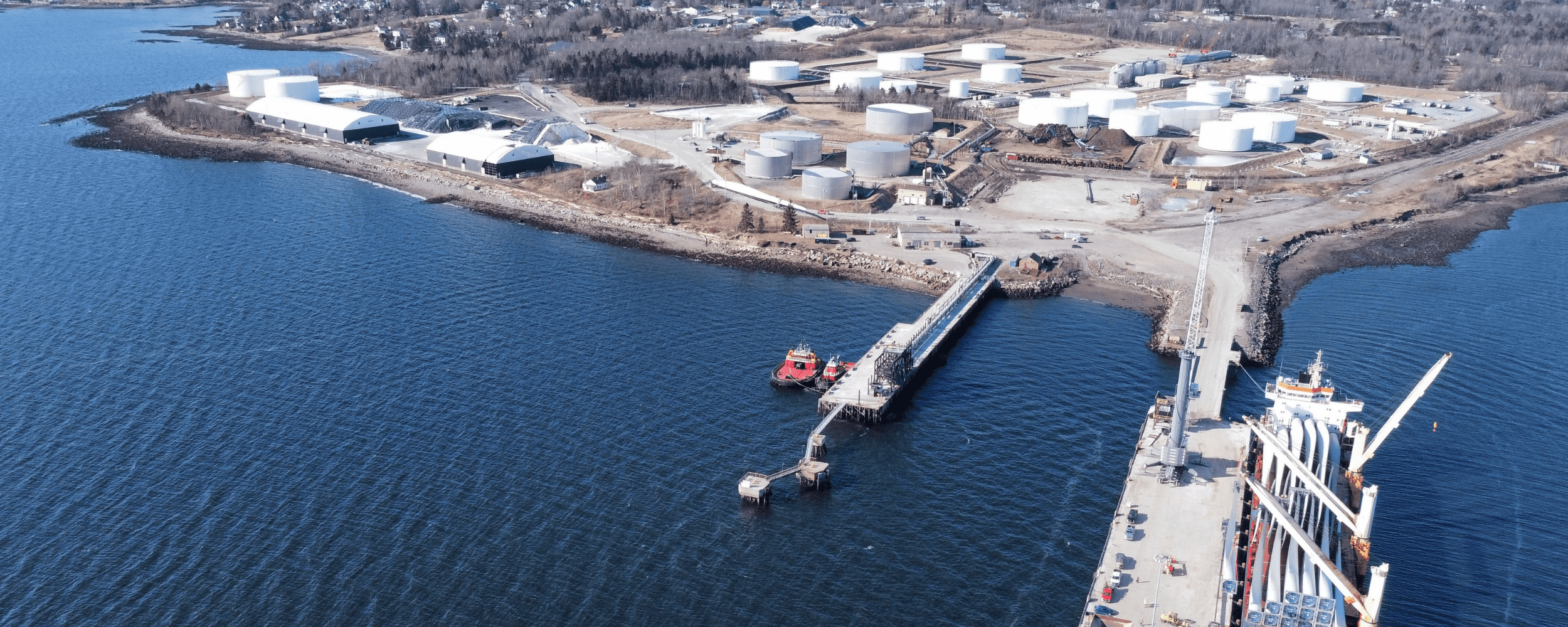Mack Point features extensive facilities such as warehousing, liquid tank storage, and significant dock frontage. In light of Governor Janet Mills' February 2024 announcement for a new port facility on Sears Island to support Maine's floating offshore wind industry, Sprague proposes Mack Point as an ideal alternative. This suggestion utilizes existing infrastructure, preserves the natural habitat on Sears Island, and aligns with Maine's renewable energy goals. Sprague's alternative plan illustrates a sustainable approach to modern energy challenges while respecting the region's ecological and historical significance.
Mack Point Benefits
Is the same size in total acres as Sears Island and even larger (110 acres) when factoring in the already existing rail infrastructure.
Has existing dredged dock cell, secondary receipt dock, roads, utilities and rail
More total dock face than Sears Island with 1,600 dedicated to large vessels and foundations while also providing up to 1,000 feet of dock space for smaller work boats and tugs.
Total project cost is anticipated to be less than Sears Island with the greatly reduced dredging and it already industrial nature creates less risk of delays in permitting.
Updated Plan Details
In light of Governor Janet Mills' February 2024 announcement for a new port facility on Sears Island to support Maine's floating offshore wind industry, Sprague proposes the DOT and Maine DEP fully compare that plan to the Mack Point alternative released by Sprague in 2023 and not the Moffat and Nichols layout from 2022.
This suggestion utilizes existing infrastructure, preserves the natural habitat on Sears Island, and aligns with Maine's renewable energy goals.
Sprague's alternative plan illustrates a sustainable approach to modern energy challenges while respecting the region's ecological and historical significance.
Updated, Low-Impact Plan: Summer 2024
- Greatly reduced dredging requirement
- Increased vessel docking capability
- Reduced wetland impact
- Reduced need for soil extractions
- Avoids potential problem areas
- Mitigates impact of fetch and southwest winds
- Provides for a stand-alone
- 100-acre wind terminal
- Provides a lower impact repurposing of an industrial site
Key Dates
Why Sprague?

One of the Largest Respected NE Energy Suppliers in the Northeast

Unprecedented Access to Energy Products & Insights Since 1870

20+ years Proven Expertise Handling of Utility Scale Wind Turbine Components
News
State should reconsider Sprague Energy plan for wind terminal at Mack Point
In late summer 2023, after working with a marine engineering firm, Sprague proposed an alternative layout, which we believe provides several compelling advantages over both the original Mack Point and the Sears Island plans proposed by the state’s contractor (Moffat & Nichol).
Our plan takes advantage of the studies undertaken by the state to maximize use of natural water depths reducing dredge requirements by up to 85 percent. In addition, it minimizes wetlands impact by avoiding an area of freshwater wetlands. Lastly, it reduces the risk of discovery of contaminated soil by limiting tank removal to an area of currently unused jet fuel tanks deemed clean by the Air Force prior to their divestiture of the former jet fuel yard. Contrary to misconceptions in some press reports, the Sprague Mack Point Terminal option is a viable, cost-effective solution and deserves full analysis.
Sprague Energy Unveils Alternative, Lower-Impact Plan for Floating Offshore Wind at Its Mack Point Terminal in Maine
PORTSMOUTH, N.H., June 6, 2024 /PRNewswire/ -- Sprague Operating Resources LLC, one of the Northeast's largest suppliers of energy products and material handling services, today released the details of its alternate plan for supporting Maine's offshore wind initiative from its Mack Point terminal, located in Searsport. The new alternative, lower impact plan was developed in the summer of 2023 with a marine engineering firm and provides several compelling advantages over both the original Mack Point and Sears Island plans proposed by the State's engineering contractor (Moffat & Nichol).
"The Sprague Energy Mack Point Terminal alternative preserves all of our current operations and minimizes dredging and wetland impact while leveraging a facility with over 20 years of wind component handling experience," said James Therriault, vice president of materials handling at Sprague. "Our Mack Point terminal has been operating in Maine since 1905. By reimagining this industrial site, we can play an integral role in achieving Maine's offshore wind energy generation goals."
Frequently Asked Questions
What are the key components of the Mack Point Terminal Alternative Proposal?
The Mack Point Terminal has been in operation since 1905 and is an already developed industrial area. By reimagining its existing footprint, Sprague ensures a low-impact plan preserving all current operations, avoids habitat destruction at Sears Island, and leverages a facility with more than 20 years of wind component handling experience.
Why is the Sprague Energy Mack Point Terminal Plan Better than The State Moffat & Nichols Plan for Sears Island or Mack Point?
There are many advantages to Sprague’s lower impact plan including:
- Already Developed with Existing Infrastructure: Much of the Sprague property is in developed industrial areas, allowing for quicker refurbishment. Mack Point benefits from existing roads, utilities, and rail, reducing the need for additional infrastructure development.
- The State has apparently modified its plan based on its May federal grant request to now include rail within the Sears Island site, Sprague already has an additional 10 acres of existing rail yard and track giving Sprague’s Mack Point Terminal 110 acres compared to the State’s plan for 100 acres.
- Less Dredging: Reduces dredging by 85% from the original plan, while staying out of the federal channel.
- Dock Frontage: Increased vessel docking capability with more than 2,600 feet of combined dock frontage.
- Dedicated Base Launching Dock: Use of stability cradle, semi-submersible barge or Tug Dock, and dedicated base assembly area out of the flow of the rest of the facility.
- Separate Fit-Up Dock: Separated from the launch dock, decreasing conflicts when lifting blades; allows for use of large assembly cranes to move ultra-heavy components.
- Greatly Increased Docking Space: Provides more total dock face than Sears Island, with 1,600 feet dedicated to large vessels and foundations. It also offers up to 1,000 feet of dock space for smaller work boats and tugs.
- Bulk Dock: Doubles as an additional component receipt dock for components using a self-propelled motor transporter, allowing for relocation of liquid vessels to both sides of current bulk dock.
- Ready to Adjust to Wind Energy while Preserving Current Capacity: Preserves all current product capacity while accommodating offshore wind development via dedicated access, new storage facilities, and infrastructure upgrades.
- Habitat Preservation and Coexisting with Wildlife: Developing Mack Point would spare destruction of 100 acres of undisturbed natural habitat on and off Sears Island, which sequesters carbon. Sprague’s plan supports clean energy generation while coexisting with Gulf wildlife.
- Building a wind port on Sears Island means more than 75 acres of upland forest will be cleared, graded, and compacted. It also means filling 25 acres of pristine Penobscot Bay to extend the shoreline where a previously protected ocean sand dune is located.
- That estimate by the State does not include the additional impact from a new and greatly expanded approach road and rail bed to get to the facility. This seriously damages the island’s ecological, recreational, and economic value.
- Re-developing Mack Point, which has thrived as an industrial site for more than a century, is a far better and less disruptive decision, and the state has previously stated that it meets the requirements for the port.
- Avoids Environmental Risks: Sprague’s plan avoids standing water, older tank farm areas, and open water wetlands.
- Cost-Effective and Quick: The total project cost for Mack Point is anticipated to be less than Sears Island due to significantly reduced dredging requirements and its already industrial nature, which minimizes the risk of delays in permitting. Moreover, Sprague’s infrastructure supports operational efficiency and a cost-effective approach that aligns with project timelines, making it a better option compared to Sears Island.
What is the truth about the dredging requirements for Mack Point in comparison to the State's claims?
The State's claims about excessive dredging at Mack Point are based on a suboptimal Moffat & Nichols plan that fails to take advantage of existing water depth. Sprague's alternative released in 2023 takes advantage of those natural water depths and a repurposed already existing liquid vessel berth to reduce dredging by 85% compared to the State's Mack Point plan. This overall dredge is minor when compared to past and planned dredges in Maine.
The States claims there will be a significant risk of the discovery of contaminated soil if Mack Point is repurposed, is this true?
No, the plan only involves removing tanks from the former US Jet fuel depot. As part of the base realignment process the federal government was required to test and certify the land was clean before its sale.
How do the construction costs compare between the State's plan and Sprague's plan?
The State's original plan for Mack Point was estimated to be marginally more expensive than Sears Island with an assumption of over $60 million in dredging costs and some additional contingencies for the relocation of Sprague assets Sprague had previously offered to fund it asset relocation and that combined with Sprague's plan reducing dredging costs by 85%, should result in a significant savings in overall construction costs to make it much lower than either Moffat & Nichols plan.
The State says that Sprague's current business will be negatively impacted by building an offshore wind facility, which would impact the citizens of Maine. Is this true, and if not, how will you avoid this?
No, there will be no impact on Sprague's current business with the offshore wind facility. The plan preserves all existing capabilities and includes a dedicated gate to minimize operational conflicts. The plan also results in the ability to receive larger sized liquid vessels on the bulk dock potentially reducing the State’s energy costs.
How does the railroad land factor into Sprague's plan?
The railroad land does not need to be purchased or removed and New ‘domestic content’ tax credits make it advantageous to be able to receive components and supplies by rail increasing the need for the exiting rail infrastructure.
Can you speak to operational efficiency and potential conflicts with the State's plan?
Sprague's design ensures operational efficiency with designated areas for each function, minimizing conflicts during construction, launch, or component reception.
It’s been said that there will be heavy costs associated with Sprague's plan. What kind of costs are we talking about?
Contrary to the State's claims, Sprague's plan promises lower upfront costs resulting in interest costs savings to the state assuming the state is required to issue revenue bonds. These savings will significantly offset any lease fees paid to Sprague.
The State believes that Sprague's plan will take longer to permit and complete, so what would you do to solve this?
That’s not correct. Sprague's plan should face fewer permitting hurdles since most of the property is already in an industrial use. This should also result in a shorter timeline for construction than the state plan.
How does Sprague's plan meet and exceed the State's design parameters?
Sprague's plan meets and exceeds original design parameters with:
- Increased Dock Frontage: More than 2,600 feet of combined dock frontage for enhanced vessel docking.
- Dedicated Launching Dock: Allows for stability cradle, barge, or tug dock use and a separate assembly area.
- Separate Fit-Up Dock: Which is separated from the launch dock, reduces conflicts, and accommodates large assembly crane use.
- Bulk Dock: An additional component receipt dock, allowing for larger vessels and potential cost savings on fuel shipments.
How does Sprague's experience benefit its alternative plan?
Sprague's extensive experience in the energy industry ensures that our alternative lower impact plan is backed by a deep understanding of energy logistics, technological advancements, and efficient handling practices, making it a better choice for sustainable energy projects.
Is Sprague really opposed to upsetting the ecosystem of Sears Island or does Sprague just want the business?
Sprague believes there is no valid reason to disrupt the intact ecosystem of Sears Island when Mack Point offers a viable and superior solution for coastal Maine.
What is Sprague's environmental stance regarding this specific project?
Sprague prioritizes environmental protection and sustainability in all of our projects which include:
- Prioritize Natural Resources: Sprague prioritizes the protection of natural resources and works to mitigate the impacts of climate change.
- Benefits of Wind Power: Sprague recognizes wind power as a reliable and clean energy source that can improve public health, protect wildlife, enhance energy security, and create local job opportunities.
- Responsible Development: Sprague strongly supports the safe and responsible development of offshore wind projects, ensuring that environmental considerations are central to our operations and initiatives
Why has Sprague waited to the last minute to release this alternative plan.
Sprague first advocated to the DOT for this alternative layout in the spring of 2023 and has only now released it more broadly because it has been unable to get it reviewed by the states contractor Moffat & Nichols. The plan was shared with the steering group in the summer of 2023.
What does Sprague want the DOT to do?
Sprague is urging the State of Maine to pause its decision until it has conducted a thorough analysis of the cost and impact of Sprague's alternative design compared to other proposals, specifically the Moffet & Nichols design. It is of paramount importance that the State understand that there is a far better solution for Maine, and Sprague’s alternative lower impact plan aligns with the policies outlined by the Maine Climate Council, which prioritize:
- Minimal Disruption to Natural Systems
- Streamlined and Transparent Project Siting
- Minimization of Impacts on Natural and Working Lands
The Governor recently rolled out a public request for information on Maine's commercial offshore wind solicitation approach and implementation, so what is Sprague doing to have a voice in this process and impact her decision-making?
Through multiple levels of proactive outreach to the press, elected officials, community members and environmental groups, Sprague is encouraging Mainers to submit their feedback and have their voices heard before the June 21st deadline by sending an email to geo@maine.gov to have their opinions heard in order to help influence the state's evaluation of solicitation design plans and program objectives.
Where can people get more information about Sprague and its alternative, lower impact plan?
We encourage all Mainers to go to www. https://www.spragueenergy.com/mack-point to learn more about Sprague’s lower impact, floating ocean wind terminal plan, which includes an email contact form anyone can complete to submit questions to our team.
